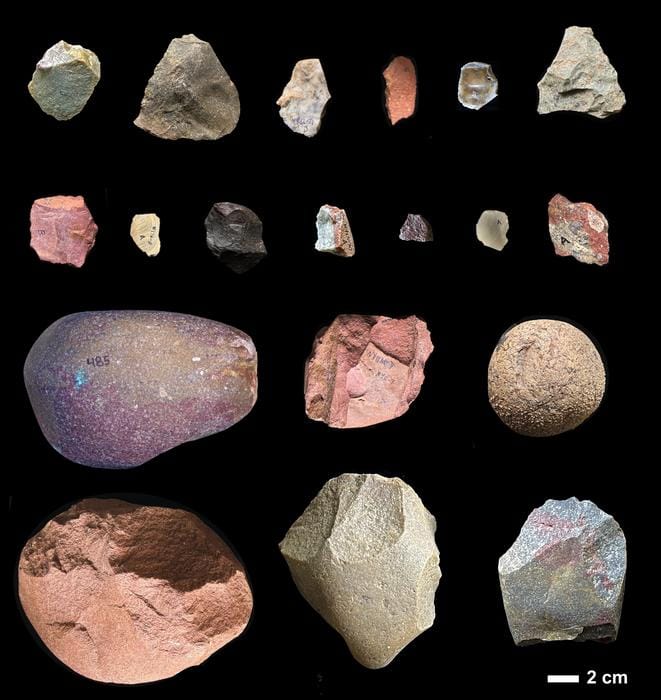For more than a million years, early humans crafted stone tools as part of the Oldowan tradition, which is the oldest sustained tool-making industry in the archaeological record. Now, scientists have discovered that Oldowan tool-makers who lived in Kenya at least 2.6 million years ago transported high-quality raw materials for tools across more than seven miles to processing sites.
The find pushes the recorded timeline of this unique behavior back half-a-million years, at minimum, and reveals that hominins possessed complex cognitive capacities, like forward planning and delayed rewards, earlier than previously known, according to a study published on Friday in Science.
Hominins at this site, called Nyayanga, used their tools to pound and cut foraged plants and scavenged animals, including hippos, to prepare them for consumption. Intriguingly, the identity of the tool-makers remains unknown, and while they may have been early humans, it’s also possible that they could have been close cousins of our own Homo lineage.
“I've always thought that early tool-makers must have had more capabilities than we sometimes give them credit for,” said Emma Finestone, associate curator and the Robert J. and Linnet E. Fritz Endowed Chair of Human Origins at the Cleveland Museum of Natural History, who led the study, in a call with 404 Media.
“I was excited to see that at 2.6 million years ago, hominins were making use of many different resources and moving stones over large distances,” she added.
While many animals craft and transport tools, hominins are unique in their ability to identify and move special materials across long distances, which the team defines as more than three kilometers (or 1.86 miles). This innovation reveals a capacity for forward planning, complex mental maps, and delayed payoff of food consumption.
“What's unique is the amount of effort put into moving resources around a landscape,” said Finestone. “There's several steps involved, and there's also time in between these efforts and the reward. Although you see that to some extent in other animals, humans really separate themselves, especially as we get further and further in evolutionary time, in terms of the complexities of our foraging system."
Previously, the earliest record of this behavior in hominins came from a site called Kanjera South, which is about two million years old. Both sites are on the Homa peninsula, a region dominated by soft rocks that are not durable as tools; this may have prompted early hominins to search elsewhere for high-quality resources, such as quartz, chert, and granite.
Given that long-distance material transport was present at Kanjera South, the discovery of similar behavior at Nyayanga was not completely unexpected—though Finestone and her colleagues were still surprised by the scope and variety of materials these hominins gathered.
“Often, when you're dealing with these really old archeological assemblages, it's dominated by one type of raw material that's coming from a single source, or a few sources that are really nearby,” said Finestone. “Nyayanga has a lot of different raw materials, and they're using a variety of different sources, so that was surprising and exciting to us.”
Finestone and her colleagues have made many discoveries during their decade-long excavation at Nyayanga. The team previously reported that the tool-makers butchered hippopotamus carcasses which were probably scavenged rather than hunted, providing the earliest evidence of hominin consumption of large animals, according to a 2023 study led by Thomas Plummer, a professor of anthropology at Queens College, City University of New York.
That study also reported fossils from Paranthropus, a close hominin cousin of our own Homo genus, which went extinct more than a million years ago. So far, these are the only hominin remains recovered from Nyayanga, raising the possibility that the Oldowan tool-making industry was not limited to our own human lineage.
“It is interesting because Paranthropus is not traditionally thought to be a tool-user,” Finestone said. “There's debate over whether Paranthropus made tools or whether it was only genus Homo that was making Oldowan tools. I don't think that evidence at Nyayanga is definitive that Paranthropus was the tool maker. It's still an open question. But because we found Paranthropus remains at Nyayanga, and we haven't found anything from genus Homo—at least yet—there's definitely reason to consider that Paranthropus might have been manufacturing these tools.”
With luck, the team may uncover more fossils from these ancient hominins that could shed light on their place in the family. Finestone and her colleagues are also working on constraining the age of the Nyayanga artifacts, which could be anywhere from 2.6 million to three million years old.
But for now, the study marks a new milestone in the evolution of Oldowan tools and their makers, which eventually dispersed across Africa and into Europe and Asia before they were succeeded by new traditions (like the one from our story last week about yet another group of ancient tool-makers with an unknown identity).
The stones once used to butcher hippos and pound tubers offer a window into the minds of bygone hominins that pioneered technologies that ultimately made humans who we are today.
“What's really interesting about humans and their ancestors is we're a technologically dependent species,” Finestone said. “We rely on tools. We're obligate tool users. We don't do it opportunistically or occasionally the way that a lot of other animals use tools. It's really become ingrained in our way of life, in our survival, and our foraging strategies across all people and all cultures.”
“What was exciting about this study is that you see this investment in tool technology, and you see tools becoming ingrained in the landscape-scale behaviors of hominins 2.6 million years ago,” she concluded. “We might be seeing the roots of this importance that technology plays in our foraging behaviors and also just the daily rhythms of our life.”

